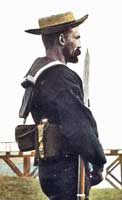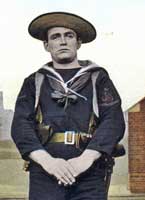Advanced Marks of Sea Service Accoutrements
or
Trials Patterns, Accoutrements, Naval, Pattern 1901?
 During research for Sea Service Accoutrements, two very interesting tinted postcards emerged, which were part of a series called The Backbone of the Navy The two at left are from the John Bird Collection. Contact was then made with Jeff Hayes, who had a set of magazines, Under The Union Jack, a contemporary Boer War publication from The Navy And Army Illustrated magazine. One front cover showed the same sailor in the first postcard, accompanied by more pictures of him, but from the front and left.
During research for Sea Service Accoutrements, two very interesting tinted postcards emerged, which were part of a series called The Backbone of the Navy The two at left are from the John Bird Collection. Contact was then made with Jeff Hayes, who had a set of magazines, Under The Union Jack, a contemporary Boer War publication from The Navy And Army Illustrated magazine. One front cover showed the same sailor in the first postcard, accompanied by more pictures of him, but from the front and left.
The latest find was an Ogden’s Guinea Gold cigarette card, which showed the same front view, at a better resolution and gave the information that he was from H.M.S. Powerful, a cruiser which landed a Bluejackets Naval Brigade, along with a second Brigade from her sister ship, H.M.S. Terrible. They were then the largest cruisers in the world and both were on the China Station. . On rotating back to the U.K., Powerful was diverted to the Cape, late in 1899, where she was joined by Terrible, the latter then returning to China, when the Boxer Rebellion broke out.
Unless development of what would become Patt. 1901 began much earlier, the probability would be that both cruisers carried sets of Sea Service Accoutrements, having been on station for almost two years. However, the sailor was wearing accoutrements that had most of the attributes of Patt. ’01 Naval Accoutrements. What was remarkable was the cover date of the periodical, 31st March 1900. This was over two years earlier than the LoC announcement of Patt. ‘01, on 1st July 1902. With no other documentation to fall back on, some speculation is therefore in order. The most plausible explanation could be that new accoutrements, still under development, had been sent out from the U.K. The opportunity for a field trial – in earnest – having presented itself, it was too good to miss. However, Powerful continued to the U.K., garnering all the plaudits. The New Pattern accoutrements may have been issued there instead.
 Self-evidently, accoutrements do not suddenly appear, having first to be invented, then manufactured, trialled and developed. This could be all that the photographs were showing. Whatever the circumstances, the question then arises as to exactly what accoutrements were being worn. Were they the Last Gasp of Victorian Sea Service Accoutrements, or were they an example of The Brave New World of the 20th Century?
Self-evidently, accoutrements do not suddenly appear, having first to be invented, then manufactured, trialled and developed. This could be all that the photographs were showing. Whatever the circumstances, the question then arises as to exactly what accoutrements were being worn. Were they the Last Gasp of Victorian Sea Service Accoutrements, or were they an example of The Brave New World of the 20th Century?
The precedence for a Last Gasp is well-established, as from 1880, the Royal Navy had spent 20 years of constantly advancing the Mark Numbers of the Sea Service Accoutrements. Some had existed even prior to this time, being formalised as “Mark I” only in 1880. It could therefore be speculated the items in the photographs were simply another Mark Number advance. The Navy had not used Pattern Years before, so did the Admiralty just fall in line with Army practice, deciding that Mark Numbers had perhaps proliferated for long enough? They might then have elected to call these latest (last?) developments by a Pattern Year. Perhaps 1901, being the first year of the New Century (oh yes, it was!), was another reason to mark the occasion?
Ignoring Mark Numbers, the Navy already had two basic forms of Belt, two basic forms of Braces and multiple forms of Ammunition pouches, Ammunition bags, Cartridge carriers, Water bottle carriages, etc. It would not be out of character to have developed Belt and Braces of a third design. In this, they would have been returning to the 1880 form, after the strange dog-leg into “.303-inch” accoutrements. The Belt would be supported by properly secured connections, back and front, as with the Army’s current Pattern 1888 Valise Equipment. They had never itemised a Cover for the Mess tin, but suddenly one is being worn in the photograph. The Carriage for the Water bottle also owes far m ore to previous naval designs.
ore to previous naval designs.
At the end of the Patt. 1901 LoC, a comment appears “…Carriages, blanket are not required with the above accoutrements…” (pictured at right). This is a definite backwards look, at what had been the standard and could be interpreted as confirming that this new set of designs at least had its origins in the previous Victorian designs, even if it was now a completely new Pattern which - in this permutation – dispensed with these Carriages.
Roger Dennis 2011